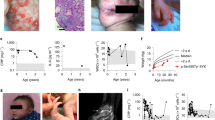Abstract
A SNP in the gene PTPN22 is associated with type 1 diabetes, rheumatoid arthritis, lupus, Graves thyroiditis, Addison disease and other autoimmune disorders. T cells from carriers of the predisposing allele produce less interleukin-2 upon TCR stimulation, and the encoded phosphatase has higher catalytic activity and is a more potent negative regulator of T lymphocyte activation. We conclude that the autoimmune-predisposing allele is a gain-of-function mutant.
This is a preview of subscription content, access via your institution
Access options
Subscribe to this journal
Receive 12 print issues and online access
$209.00 per year
only $17.42 per issue
Buy this article
- Purchase on Springer Link
- Instant access to full article PDF
Prices may be subject to local taxes which are calculated during checkout


Similar content being viewed by others
References
Mustelin, T., Vang, T. & Bottini, N. Nat. Rev. Immunol. 5, 43–67 (2005).
Tsui, H.W., Siminovitch, K.A., de Souza, L. & Tsui, F.W. Nat. Genet. 4, 124–129 (1993).
Majeti, R. et al. Cell 103, 1059–1069 (2000).
Hasegawa, K. et al. Science 303, 685–689 (2004).
Bottini, N. et al. Nat. Genet. 36, 337–338 (2004).
Smyth, D. et al. Diabetes 53, 3020–3023 (2004).
Ladner, M.B., Bottini, N., Valdes, A.M. & Noble, J.A. Hum. Immunol. 66, 60–64 (2005).
Begovich, A.B. et al. Am. J. Hum. Genet. 75, 330–337 (2004).
Siminovitch, K. Nat. Genet. 36, 1248–1249 (2004).
Gottlieb, P.A. & Eisenbarth, G.S. in The Molecular Pathology of Autoimmune Diseases 2nd edn. (A. Theofilopoulos & C.A. Bona, eds.) 588–613 (Taylor & Francis, New York, 2002).
Gjörloff-Wingren, A., Saxena, M., Williams, S., Hammi, D. & Mustelin, T. Eur. J. Immunol. 29, 3845–3854 (1999).
Salojin, K.V., Zhang, J., Madrenas, J. & Delovitch, T.L. Immunol. Today 19, 468–473 (1998).
Delovitch, T.L. & Singh, B. Immunity 7, 727–738 (1997).
Sakaguchi, N. et al. Nature 426, 454–460 (2003).
Vang, T. et al. Eur. J. Immunol. 34, 2191–2199 (2004).
Acknowledgements
We thank A. Cao for suggestions and P. Frongia, P. Pusceddu, M. Chessa and R. Riccardi for recruiting affected individuals and collecting blood samples. This work was supported by a fellowship from the Norwegian Cancer Society (to T.V.) and by grants from the Juvenile Diabetes Research Foundation (to N.B.), Telethon-JDRF (to F.C.) and the US National Institutes of Health (to T.M).
Author information
Authors and Affiliations
Corresponding author
Ethics declarations
Competing interests
The authors declare no competing financial interests.
Supplementary information
Supplementary Fig. 1
Analysis of T cell lineages and subpopulations in T1D children of RW or RR genotype. (PDF 151 kb)
Supplementary Fig. 2
The disease-associated LYP*W620 is a more potent inhibitor of early TCR signaling. (PDF 111 kb)
Rights and permissions
About this article
Cite this article
Vang, T., Congia, M., Macis, M. et al. Autoimmune-associated lymphoid tyrosine phosphatase is a gain-of-function variant. Nat Genet 37, 1317–1319 (2005). https://doi.org/10.1038/ng1673
Received:
Accepted:
Published:
Issue Date:
DOI: https://doi.org/10.1038/ng1673



